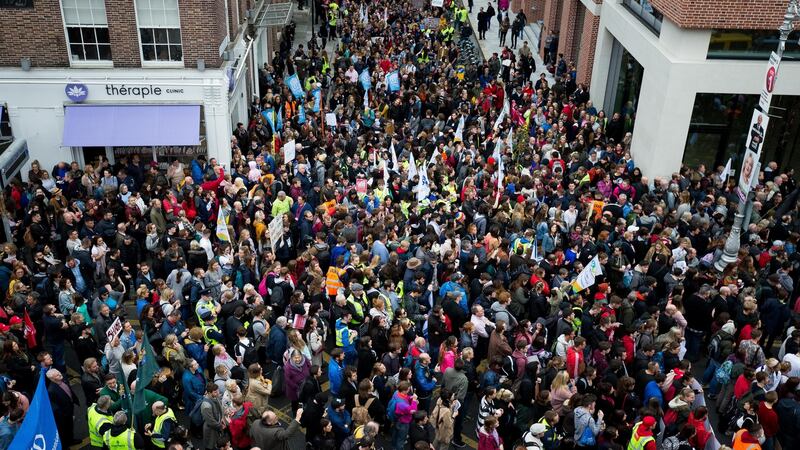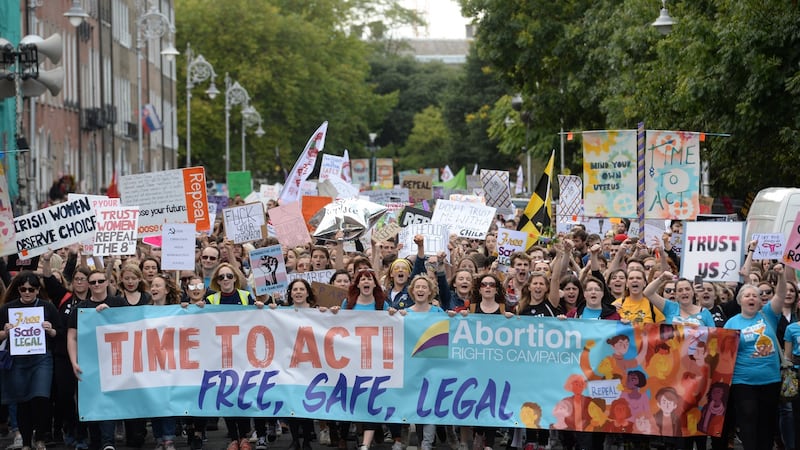Last Wednesday saw the culmination of the early stages of a housing movement being willed into action out of desperation and righteous anger. Ten thousand people gathering at a rally in Dublin city centre on a weekday at lunchtime is simply phenomenal.
A movement has many authors, but it is remarkable how quickly it has gone from a small number of activists occupying properties in the north inner city to this display of mass protest.
The discontent with failed housing policy is visceral, but equally energetic is a feeling of enthusiasm and potential for this movement. As a movement grows, it inevitably stretches to include an eclectic range of participants.
Frequently overlooked, and sometimes even disparaged in Irish politics and activism, are students, who arrived at the Raise The Roof rally in their thousands. The mobilisation of a new generation of students in recent years as a strong activist force is hugely significant.

Like many people, students have been shouting about the housing crisis for years now, considering they experience it acutely every autumn when colleges restart and new and existing students are left sleeping on friends’ couches or commuting for hours. Those recent experiences were the canary in the mine, a microcosm of an escalating rental crisis that was being ignored.
Those same students had their calls for affordable accommodation thrown back in their faces with the building of unaffordable “student accommodation” complexes in parts of Dublin that were traditionally cheap enough for students to live in.
The less involved that political parties are in 'people's' activism, the better
Of course, if the crowd was just made up of students, government might feel as though it could relax a little. But as predicted, the housing movement is diverse. The ire articulated by some at the presence of Labour Party members at the protest is inevitable. People are obviously entitled to be angry at the Labour Party for their failings and perceived betrayals.
But as those who are working on the ground know, building a movement is about building alliances. It is about reaching across many aisles to work with and include people you may disagree with.
Solidarity is about support and togetherness, but it’s also about empathy and the capacity to stand with people who may be coming from different places and different points of view, and saying: you’re not like me, but I stand with you, and so let’s stand together. The most encouraging moments I’ve experienced at protests are when I look around and realise it’s not just people like me there.
I think the less involved that political parties are in “people’s” activism, the better. We are right to be wise to hijacking and bandwagoning and capitalising on ground-up stuff for top-down gain. Movements can get strangled when they divide down party lines.

With marriage equality and the Repeal movement, we have seen how the people led and politicians followed. Some conflict is inevitable. Movements are fraught. Ideological conflict within movements can be useful. It is important to self-examine. But imposing a hierarchy of the “right kind” and “wrong kind” of protester is playing into the hands of those who seek to divide and conquer.
If you take a look at the marriage equality movement, there was a time when people in Marriage Equality (the organisation) and GLEN could not stand each other. When I wrote an oral history of the movement, one campaigner described this conflict as so visceral it was equivalent to “civil war”.
But in the drive to achieve a single goal, those two groups came together. Brian Sheehan (GLEN) and Grainne Healy (Marriage Equality) became co-directors of Yes Equality and led the referendum campaign together. Alliances are always going to be more disruptive to conservatism than divisions.
Movements need to be collaborative, they need to be flexible, they need to create multiple entry points
I've frequently returned to something the author and activist Sarah Schulman said when I interviewed her earlier this year when she spoke about the success of ACT UP (AIDS Coalition To Unleash Power), "If you look at the AIDS movement, you have all this simultaneity of action. One of the really interesting things in ACT UP is that if I wanted to do something, and you didn't want to do it, you wouldn't stop me from doing it, you just wouldn't do it.
“So you had some people who were like ‘we should go to Saint Patrick’s Cathedral and interrupt mass because the Catholic Church is trying to take condoms out of the schools’, and then you had other people who were like ‘oh that’s horrible,’ but they wouldn’t stop us from doing it. They would go to the Lower East Side and do needle exchange, because that’s what they wanted to do. The movement was flexible enough to accommodate everything because people were dying and we were in a state of emergency.
“Often when people are really in a state of emergency, they’re much more effective. It’s when people are comfortable that they’re not effective, because they don’t really need change. If you really need change, you can be more inventive.”
Movements need to be collaborative, they need to be flexible, they need to create multiple entry points for loads of people from all walks of life and political persuasions to participate. Movements cannot be rigid because rigidness excludes people. Exclusion can be a form of elitism, which is the very thing we should be fighting against.












